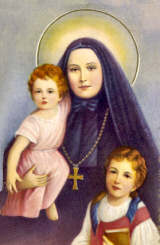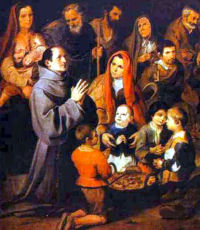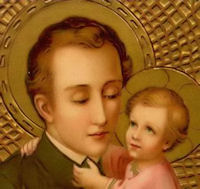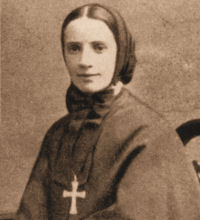Daily Readings for: November 13, 2012
(Readings on USCCB website)
Collect: God our Father, who called Saint Frances Xavier Cabrini from Italy to serve the immigrants of America, by her example, teach us to have concern for the stranger, the sick, and all those in need, and by her prayers help us to see Christ in all the men and women we meet. Through our Lord Jesus Christ, your Son, who lives and reigns with you in the unity of the Holy Spirit, one God, for ever and ever.
RECIPES
ACTIVITIES
PRAYERS
LIBRARY
Ordinary Time: November 13th
Memorial of St. Frances Xavier Cabrini, virgin (USA)
Old Calendar: St. Didacus, confessor; St. Stanislaus Kostka (Hist)
Today the dioceses in the United States celebrate the memorial of St. Frances Xavier Cabrini, virgin, born in Lombardy, Italy, one of thirteen children. She came to America as a missionary, founded the Missionary Sisters of the Sacred Heart to care for poor children in schools and hospitals. She is the first American citizen to be canonized. December 22 is her feast day in the Extraordinary Rite.
According to the 1962 Missal of Bl. John XXIII the Extraordinary Form of the Roman Rite, today is the feast of St. Didacus, a humble Franciscan laybrother and the recipient of exceptional graces. He received such light from God that he spoke of heavenly things in a manner almost divine; certain miracles, but especially his obedience, charity and fervor of his prayer, caused him to be considered a saint wherever he went. He was born in Andalusia, was sent as a missionary to the Canary Isles, spent some time in Rome and returned to die in Spain.
St. Frances Xavier Cabrini
 This saint, the first United States citizen to be canonized, was born in Italy of parents who were farmers. She was the thirteenth child, born when her mother was fifty-two years old. The missionary spirit was awakened in her as a little girl when her father read stories of the missions to his children. She received a good education, and at eighteen was awarded the normal school certificate.
This saint, the first United States citizen to be canonized, was born in Italy of parents who were farmers. She was the thirteenth child, born when her mother was fifty-two years old. The missionary spirit was awakened in her as a little girl when her father read stories of the missions to his children. She received a good education, and at eighteen was awarded the normal school certificate.
For a while she helped the pastor teach catechism and visited the sick and the poor. She also taught school in a nearby town, and for six years supervised an orphanage assisted by a group of young women. The bishop of Lodi heard of this group and asked Frances to establish a missionary institute to work in his diocese. Frances did so, calling the community the Missionary Sisters of the Sacred Heart. An academy for girls was opened and new houses quickly sprang up.
One day Bishop Scalabrini, founder of the Missionaries of Emigration, described to Mother Cabrini the wretched economical and spiritual conditions of the many Italian immigrants in the United States, and she was deeply moved. An audience with Pope Leo XIII changed her plans to go to the missions of the East. "Not to the East, but to the West," the Pope said to her. "Go to the United States." Mother Cabrini no longer hesitated. She landed in New York in 1889, established an orphanage, and then set out on a lifework that comprised the alleviation of every human need. For the children she erected schools, kindergartens, clinics, orphanages, and foundling homes, and numbers of hospitals for the needy sick. At her death over five thousand children were receiving care in her charitable institutions, and at the same time her community had grown to five hundred members in seventy houses in North and South America, France, Spain, and England.
The saint, frail and diminutive of stature, showed such energy and enterprise that everyone marveled. She crossed the Atlantic twenty-five times to visit the various houses and institutions. In 1909 she adopted the United States as her country and became a citizen. After thirty-seven years of unflagging labor and heroic charity she died alone in a chair in Columbus Hospital at Chicago, Illinois, while making dolls for orphans in preparation for a Christmas party. Cardinal Mundelein of Chicago officiated at her funeral and in 1938 also presided at her beatification by Pius XI. She was canonized by Pius XII in 1946. She lies buried under the altar of the chapel of Mother Cabrini High School in New York City. — A Saint A Day, Berchmans Bittle, O.F.M.Cap.
Patron: hospital administrators; immigrants; orphans.
Symbols: ship; heart; book.
Things to Do:
St. Didacus
 Didacus (or Diego, Jacob) was born in the town of San Nicolas, Andalusia. From early youth he showed a love for solitude. At Arrizafa, near Cordova, he became a Franciscan brother and was outstanding in humility and obedience. He had little formal education, yet through divine enlightenment in no way lacked wisdom. As a missionary he visited the Canary Islands and was appointed first superior of the new foundation there. In 1450 Pope Nicholas V confided to his care the sick in the celebrated convent of Ara Caeli. With his tongue he often cleansed the wounds of the sick. He miraculously healed many with oil from the lamp which burned before a picture of the Blessed Virgin or with the sign of the Cross.
Didacus (or Diego, Jacob) was born in the town of San Nicolas, Andalusia. From early youth he showed a love for solitude. At Arrizafa, near Cordova, he became a Franciscan brother and was outstanding in humility and obedience. He had little formal education, yet through divine enlightenment in no way lacked wisdom. As a missionary he visited the Canary Islands and was appointed first superior of the new foundation there. In 1450 Pope Nicholas V confided to his care the sick in the celebrated convent of Ara Caeli. With his tongue he often cleansed the wounds of the sick. He miraculously healed many with oil from the lamp which burned before a picture of the Blessed Virgin or with the sign of the Cross.
During a stay at the friary at Alcala in 1463, Didacus felt the approach of his last hour. Wrapped in discarded rags, with eyes fixed immovably upon a crucifix, he died while fervently praying the words of the hymn Dulce lignum, dulces clavos, O sweet wood, O sweet nails that held so sweet a burden! For a long time his body remained incorrupt. — The Church's Year of Grace, Pius Parsch.
Patron: diocese of San Diego, California; Franciscan laity; Franciscan lay brothers.
Symbols: Bread and roses in a tunic; cross held by an angel.
Things to Do: Meditate on the fact that in order to walk the Christian path you must always be counter-cultural, for the world follows the broad, level and easy roads, and resolve to bear patiently the next time someone misunderstands you or even ridicules you because you do not conform to this world (pray for that person); Pray for the virtue of humility which we must have if we are to reach our "enemies".
St. Stanislaus Kostka
 The son of a Polish senator, St. Stanislaus was first privately educated at the family castle. He later attended the Jesuit college in Vienna, where he set a holy example for all. While at the college, Stanislaus suffered from a serious illness. St. Barbara and two angels appeared to him and he seemed to be given Holy Communion in the vision (either by St. Barbara or by the angels). Also, Our Lady visited him and told him that he would recover and become a Jesuit. The Jesuit provincial in Vienna was too afraid of making Stanislaus's father angry to admit Stanislaus to the Order, so the saint walked to Augsburg and then Dillingen, a total of 350 miles, and there appealed to St. Peter Canisius, the Jesuit provincial of Upper Germany. St. Peter Canisius took him in, and after three weeks, sent Stanislaus to Rome to see St. Francis Borgia, who was general of the Jesuits. In Rome, Stanislaus became a Jesuit at the age of 17, much to the dissatisfaction of his father. His devotion to the Eucharist was apparent to all, since he went into ecstasy after receiving Communion. St. Stanislaus became ill again and died only nine months into his novitiate.
The son of a Polish senator, St. Stanislaus was first privately educated at the family castle. He later attended the Jesuit college in Vienna, where he set a holy example for all. While at the college, Stanislaus suffered from a serious illness. St. Barbara and two angels appeared to him and he seemed to be given Holy Communion in the vision (either by St. Barbara or by the angels). Also, Our Lady visited him and told him that he would recover and become a Jesuit. The Jesuit provincial in Vienna was too afraid of making Stanislaus's father angry to admit Stanislaus to the Order, so the saint walked to Augsburg and then Dillingen, a total of 350 miles, and there appealed to St. Peter Canisius, the Jesuit provincial of Upper Germany. St. Peter Canisius took him in, and after three weeks, sent Stanislaus to Rome to see St. Francis Borgia, who was general of the Jesuits. In Rome, Stanislaus became a Jesuit at the age of 17, much to the dissatisfaction of his father. His devotion to the Eucharist was apparent to all, since he went into ecstasy after receiving Communion. St. Stanislaus became ill again and died only nine months into his novitiate.
Patron: Poland; young students.

 This saint, the first United States citizen to be canonized, was born in Italy of parents who were farmers. She was the thirteenth child, born when her mother was fifty-two years old. The missionary spirit was awakened in her as a little girl when her father read stories of the missions to his children. She received a good education, and at eighteen was awarded the normal school certificate.
This saint, the first United States citizen to be canonized, was born in Italy of parents who were farmers. She was the thirteenth child, born when her mother was fifty-two years old. The missionary spirit was awakened in her as a little girl when her father read stories of the missions to his children. She received a good education, and at eighteen was awarded the normal school certificate.  Didacus (or Diego, Jacob) was born in the town of San Nicolas, Andalusia. From early youth he showed a love for solitude. At Arrizafa, near Cordova, he became a Franciscan brother and was outstanding in humility and obedience. He had little formal education, yet through divine enlightenment in no way lacked wisdom. As a missionary he visited the Canary Islands and was appointed first superior of the new foundation there. In 1450 Pope Nicholas V confided to his care the sick in the celebrated convent of Ara Caeli. With his tongue he often cleansed the wounds of the sick. He miraculously healed many with oil from the lamp which burned before a picture of the Blessed Virgin or with the sign of the Cross.
Didacus (or Diego, Jacob) was born in the town of San Nicolas, Andalusia. From early youth he showed a love for solitude. At Arrizafa, near Cordova, he became a Franciscan brother and was outstanding in humility and obedience. He had little formal education, yet through divine enlightenment in no way lacked wisdom. As a missionary he visited the Canary Islands and was appointed first superior of the new foundation there. In 1450 Pope Nicholas V confided to his care the sick in the celebrated convent of Ara Caeli. With his tongue he often cleansed the wounds of the sick. He miraculously healed many with oil from the lamp which burned before a picture of the Blessed Virgin or with the sign of the Cross.  The son of a Polish senator, St. Stanislaus was first privately educated at the family castle. He later attended the Jesuit college in Vienna, where he set a holy example for all. While at the college, Stanislaus suffered from a serious illness. St. Barbara and two angels appeared to him and he seemed to be given Holy Communion in the vision (either by St. Barbara or by the angels). Also, Our Lady visited him and told him that he would recover and become a Jesuit. The Jesuit provincial in Vienna was too afraid of making Stanislaus's father angry to admit Stanislaus to the Order, so the saint walked to Augsburg and then Dillingen, a total of 350 miles, and there appealed to St. Peter Canisius, the Jesuit provincial of Upper Germany. St. Peter Canisius took him in, and after three weeks, sent Stanislaus to Rome to see St. Francis Borgia, who was general of the Jesuits. In Rome, Stanislaus became a Jesuit at the age of 17, much to the dissatisfaction of his father. His devotion to the Eucharist was apparent to all, since he went into ecstasy after receiving Communion. St. Stanislaus became ill again and died only nine months into his novitiate.
The son of a Polish senator, St. Stanislaus was first privately educated at the family castle. He later attended the Jesuit college in Vienna, where he set a holy example for all. While at the college, Stanislaus suffered from a serious illness. St. Barbara and two angels appeared to him and he seemed to be given Holy Communion in the vision (either by St. Barbara or by the angels). Also, Our Lady visited him and told him that he would recover and become a Jesuit. The Jesuit provincial in Vienna was too afraid of making Stanislaus's father angry to admit Stanislaus to the Order, so the saint walked to Augsburg and then Dillingen, a total of 350 miles, and there appealed to St. Peter Canisius, the Jesuit provincial of Upper Germany. St. Peter Canisius took him in, and after three weeks, sent Stanislaus to Rome to see St. Francis Borgia, who was general of the Jesuits. In Rome, Stanislaus became a Jesuit at the age of 17, much to the dissatisfaction of his father. His devotion to the Eucharist was apparent to all, since he went into ecstasy after receiving Communion. St. Stanislaus became ill again and died only nine months into his novitiate.